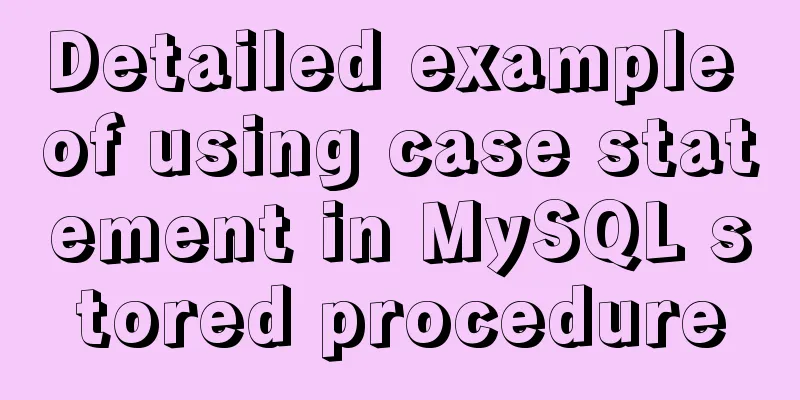Detailed explanation of MySQL custom functions and stored procedures

|
Preface This article mainly introduces the relevant content about MySQL custom functions and stored procedures, and shares it for your reference and learning. Let’s take a look at the detailed introduction. 1. Prerequisites There is a table user_info in the MySQL database, and its structure and data are as follows: mysql> desc user_info; +-----------+----------+------+-----+---------+-------+ | Field | Type | Null | Key | Default | Extra | +-----------+----------+------+-----+---------+-------+ | id | int(10) | NO | PRI | NULL | | | name | char(20) | NO | | NULL | | | passwd | char(40) | NO | | NULL | | | email | char(20) | NO | | NULL | | | phone | char(20) | NO | | NULL | | | role | char(10) | NO | | NULL | | | sex | char(10) | NO | | NULL | | | status | int(10) | NO | | NULL | | | createAt | datetime | NO | | NULL | | | exprAt | datetime | NO | | NULL | | | validDays | int(10) | NO | | NULL | | | delAt | datetime | YES | | NULL | | +-----------+----------+------+-----+---------+-------+ 12 rows in set (0.10 sec) mysql> select * from user_info; +----+--------------+----------+------------+-------------+----------+--------+---------------------+---------------------+-----------+-------+ | id | name | passwd | email | phone | role | sex | status | createAt | exprAt | validDays | delAt | +----+--------------+----------+------------+-------------+----------+--------+---------------------+---------------------+-----------+-------+ | 1 | StephenWang7 | py123456 | [email protected] | 15103887470 | admin | male | 200 | 2019-04-12 20:11:30 | 2019-04-19 20:11:30 | 30 | NULL | | 2 | StephenWang8 | 123456 | [email protected] | 15103887470 | viewer | male | 200 | 2019-04-12 20:11:30 | 2019-04-19 20:11:30 | 30 | NULL | +----+--------------+----------+------------+-------------+----------+--------+---------------------+---------------------+-----------+-------+ 2 rows in set (0.00 sec) 2. Custom functions Function: A set of SQL statements that can perform specific functions. MySQL supports custom functions to complete specific business functions. The syntax for creating a user defined function (UDF) is as follows:
The syntax for calling a UDF is as follows:
Creating a UDF with no parameters Example 1: Query the number of records in the user_info table #Define function mysql> create function user_info_count() -> returns int(10) -> return -> (select count(*) from user_info); Call the function user_info_count() mysql> select user_info_count(); +-------------------+ | user_info_count() | +-------------------+ | 2 | +-------------------+ 1 row in set (0.00 sec) Creating a UDF with parameters Example 2: Query user name based on id. #Define function mysql> create function queryNameById(uid int(10)) -> returns char(20) -> return -> (select name from user_info where id=uid); Query OK, 0 rows affected (0.01 sec) Call the function to query the user name with id 1. mysql> select queryNameById(1); +------------------+ | queryNameById(1) | +------------------+ |StephenWang7| +------------------+ 1 row in set (0.00 sec) View UDF Query all UDFs in the system show function status; Query the specified UDF # show create function function name; mysql> show function queryNameById; ERROR 1064 (42000): You have an error in your SQL syntax; check the manual that corresponds to your MySQL server version for the right syntax to use near 'queryNameById' at line 1 mysql> show function queryNameById(); ERROR 1064 (42000): You have an error in your SQL syntax; check the manual that corresponds to your MySQL server version for the right syntax to use near 'queryNameById()' at line 1 mysql> show create function queryNameById(); ERROR 1064 (42000): You have an error in your SQL syntax; check the manual that corresponds to your MySQL server version for the right syntax to use near '()' at line 1 mysql> show create function queryNameById; +---------------+-----------------------------------------------------------------------------------------------------------------------------------------------------------+-----------------------------------------------------------------------------------------------------------------------------------------------+----------------------+----------------------+ | Function | sql_mode | Create Function | character_set_client | collation_connection | Database Collation | +---------------+-----------------------------------------------------------------------------------------------------------------------------------------------------------+-----------------------------------------------------------------------------------------------------------------------------------------------+----------------------+----------------------+ | queryNameById | ONLY_FULL_GROUP_BY,STRICT_TRANS_TABLES,NO_ZERO_IN_DATE,NO_ZERO_DATE,ERROR_FOR_DIVISION_BY_ZERO,NO_AUTO_CREATE_USER,NO_ENGINE_SUBSTITUTION | CREATE DEFINER=`root`@`localhost` FUNCTION `queryNameById`(uid int(10)) RETURNS char(20) CHARSET latin1 return (select name from user_info where id=uid) | utf8 | utf8_general_ci | latin1_swedish_ci | +---------------+-----------------------------------------------------------------------------------------------------------------------------------------------------------+-----------------------------------------------------------------------------------------------------------------------------------------------+----------------------+----------------------+ 1 row in set (0.00 sec Modifying UDF If you want to modify the contents of a function, delete it and then recreate it. Deleting a UDF The syntax for deleting a UDF is as follows:
Example 3: Delete the queryNameId function and call it again to observe the phenomenon. mysql> drop function queryNameById; Query OK, 0 rows affected (0.45 sec) mysql> select queryNameById(1); ERROR 1305 (42000): FUNCTION rms.queryNameById does not exist mysql> 3. Stored Procedures A stored function is similar to a custom function, and is also a set of SQL statements that perform specific functions. Write complex or frequently called SQL in advance and assign a name to it. When you want to use it, just call it. The syntax for defining a stored procedure is as follows:
Creating a stored procedure without parameters Example 4: Query user name. mysql> DELIMITER // mysql> craete procedure queryName() -> begin -> select name from user_info; -> end // Regarding the DELIMITER command, modify the character that ends the MySQL command. The default end command character is a semicolon. When a stored procedure contains multiple statements, the first semicolon will be used as a sign of the end of the stored procedure. This is not as expected, so the default end-of-command character needs to be modified. DELIMITER // is to change the end command character to //. The command to call a stored procedure is: call stored procedure name. #The end symbol of the command at this time is // not; mysql> call queryName() // +--------------+ | name | +--------------+ |StephenWang7| |StephenWang8| +--------------+ 2 rows in set (0.00 sec) Query OK, 0 rows affected (0.00 sec) Creating a stored procedure with parameters Example 5: Query name based on id. mysql> create procedure queryNameById -> (In uid int(15)) -> begin -> select name from user_info where id=uid; -> end -> // Query OK, 0 rows affected (0.03 sec) Call the stored procedure queryNameById mysql> call queryNameById(1); -> // +--------------+ | name | +--------------+ |StephenWang7| +--------------+ 1 row in set (0.03 sec) Query OK, 0 rows affected (0.04 sec) Modify the stored procedure If you want to create the contents of a stored procedure, you can delete it and then re-create it. View stored procedures show create procedure <procedure name> mysql> show create procedure queryNameById; -> // +---------------+-------------------------------------------------------------------------------------------------------------------------------------------+-----------------------------------------------------------------------------------------------------------------------------------+----------------------+----------------------+--------------------+ | Procedure | sql_mode | Create Procedure | character_set_client | collation_connection | Database Collation | +---------------+-------------------------------------------------------------------------------------------------------------------------------------------+-----------------------------------------------------------------------------------------------------------------------------------+----------------------+----------------------+--------------------+ | queryNameById | ONLY_FULL_GROUP_BY,STRICT_TRANS_TABLES,NO_ZERO_IN_DATE,NO_ZERO_DATE,ERROR_FOR_DIVISION_BY_ZERO,NO_AUTO_CREATE_USER,NO_ENGINE_SUBSTITUTION | CREATE DEFINER=`root`@`localhost` PROCEDURE `queryNameById`(In uid int(15)) begin select name from user_info where id=uid; end | utf8 | utf8_general_ci | latin1_swedish_ci | +---------------+-------------------------------------------------------------------------------------------------------------------------------------------+-----------------------------------------------------------------------------------------------------------------------------------+----------------------+----------------------+--------------------+ 1 row in set (0.04 sec) Deleting a stored procedure
Delete the stored procedure queryNameById mysql> drop procedure queryNameById // Query OK, 0 rows affected (0.02 sec) mysql> call queryNameById(1) // ERROR 1305 (42000): PROCEDURE rms.queryNameById does not exist 4. Summary Custom functions and stored procedures are both SQL sets that perform specific functions, so what are the differences between them? a. Different calling methods
b. Custom functions cannot have output parameters, but stored procedures can. c. A custom function must contain a return statement, but a stored procedure does not. Summarize The above is the full content of this article. I hope that the content of this article will have certain reference learning value for your study or work. Thank you for your support of 123WORDPRESS.COM. You may also be interested in:
|
<<: vue.js downloads pictures according to picture url
>>: Tutorial on installing rabbitmq using yum on centos8
Recommend
Win10 installation of MySQL5.7.18winX64 failed to start the server and no error message
System environment: Win10 64-bit MySQL version: m...
JavaScript Shorthand Tips
Table of contents 1. Merge arrays 2. Merge arrays...
Analysis of the usage of process control functions/statistical functions/grouping queries in MySql
The road ahead is long and arduous, but I will co...
Detailed explanation of MySQL 5.7 MGR single master determination master node method
Our bank's MGR will be launched at the end of...
Detailed explanation of server-id example in MySQL master-slave synchronization
Preface When we build a MySQL cluster, we natural...
Solution to the problem that the configuration file my.cnf in MySQL cannot be started due to permission issues
This article mainly introduces the relevant solut...
Common scenarios and avoidance methods for index failure in MySQL
Preface I have read many similar articles before,...
Various types of MySQL indexes
What is an index? An index is a data structure th...
10 Best Practices for Building and Maintaining Large-Scale Vue.js Projects
Table of contents 1. Use slots to make components...
Detailed explanation of calculated properties, monitoring properties and life cycle in Vue.js
Table of contents Preface Computed properties Int...
JavaScript function call, apply and bind method case study
Summarize 1. Similarities Both can change the int...
mysql5.7.19 winx64 decompressed version installation and configuration tutorial
Recorded the installation tutorial of mysql 5.7.1...
Html tips to make your code semantic
Html semantics seems to be a commonplace issue. G...
JS realizes simple picture carousel effect
This article shares the specific code of JS to ac...
Use pictures to realize personalized underline of hyperlinks
Don't be surprised if you see some kind of und...









